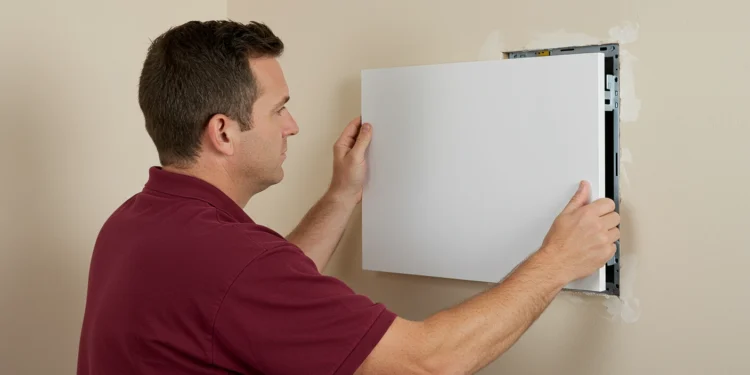Frustrating issues like flickering lights, cold spots, or mysterious leaks can signal serious issues in a home’s systems. Finding them typically involves tearing apart finished walls, which is messy, costly, and can jeopardize client trust.
Good thing, there is a better solution: general-purpose access doors. These panels simplify future maintenance and repairs, saving time and improving workflow. By incorporating smart access features, you enhance convenience and reduce costly callbacks.
The Old Way vs. The Smart Way
Instead of tearing things apart, installing general-purpose access doors offers a smarter solution. They make it easier to fix leaks quickly and efficiently, helping reduce labor time and avoid unnecessary damage to walls or tiles.
What Are General-Purpose Access Doors
As said, general-purpose access doors help easily access hidden areas in a home by allowing entry to important spaces without damaging walls or ceilings. Builders, designers, and owners must understand these components to improve residential projects.
They are often found in:
- Behind Bathtubs or Showers: They provide quick access to plumbing valves and shower mixers, preventing costly tile repairs.
- Near HVAC Units: These doors allow easy access to filters and ducts, making routine maintenance simple.
- Around Electrical Junction Boxes or Sub-Panels: They help electricians check and service wiring safely without harming the drywall.
- Attic and Crawl Space Entries: Access doors create stylish entry points better than simple cut-outs.
- Behind Wall-Mounted TVs: They help manage wires and outlets discreetly, keeping living spaces organized.
- Under Sinks: These doors quickly access important parts like garbage disposal and shut-off valves, reducing homeowners’ stress.
- Around Water Heaters: They provide easy access to essential equipment, ensuring everything runs smoothly.
A quality access door strikes a balance between durability and clean design. Most are made from sturdy materials like steel or high-impact plastic, built to handle repeated use without warping or rusting.
Many models are paintable, allowing them to blend into surrounding finishes, and they’re available in a wide range of sizes with optional locks for added security or customization based on the application.
Choosing the Right General-Purpose Access Door
The right general-purpose access door is essential for performance, overall safety, and satisfaction. Add these considerations to your checklist to enhance your projects:
Material Choices
- Plastic/ABS: Lightweight and affordable, ideal for wet areas like bathrooms due to corrosion resistance.
- Steel/Metal: Durable and paintable, it is available in fire-rated options that follow safety standards (look for UL or similar certifications).
- Drywall Inlay: Provides a discreet solution that blends seamlessly with the wall.
Size
Correct sizing is important. Measure carefully to ensure access doors accommodate necessary tools and maintenance without damaging surrounding elements.
Latching Options
Choose a latch based on security and ease of use:
- Thumb Latches: Quick, tool-free access.
- Screwdriver Cams: Secure closure requires a simple tool.
- Key Locks: Essential for restricted areas, like multi-unit buildings.
Design
Aesthetics matter. Go for paintable doors that match the surrounding area and flush designs that reduce visual clutter. A well-chosen access door enhances both functionality and appearance.
Tips for Builders
Consider installation location, part size, and desired aesthetics. Miami general contractors recommend evaluating access points early in the project to avoid delays and ensure a smooth workflow. These factors will save time and prevent costly changes, highlighting your professionalism in every project.
Installation Made Simple
A proper installation ensures the door sits flush, opens and closes smoothly, and stays securely in place without damaging the surrounding surface. It also helps maintain the integrity of the wall or ceiling, preventing issues like air leakage, water intrusion, or warping that can result from a poor fit.
When installed correctly, access doors blend cleanly into the finished surface and provide quick, unobstructed entry to important systems. This improves the overall appearance of the space and reduces the need for invasive work during future maintenance or inspections.
Here are the key steps to install access doors properly:
- Cutting the Opening: It is easy to create a clean and precise opening in drywall, plaster, or tile.
- Securing the Frame: The door frame fits into the opening and can be securely fastened to nearby studs or joists with screws.
- Finishing Touches: After securing the frame, paint or texture the area to blend the access door into the wall or ceiling.
This efficient installation reduces disruptions during construction and avoids costly repairs later. Always measure openings carefully and ensure support around the access point for a smooth installation and professional results.
Your Next Smart Build Starts Here
Access doors offer a simple way to improve the function and longevity of residential builds. For general contractors, builders, and remodelers, they provide a practical solution that can prevent delays and reduce the need for rework. Electricians, plumbers, and HVAC specialists benefit from easier access during installation and service checks, saving time and avoiding extra labor.
Homeowners also see the value. Instead of costly repairs that involve cutting into finished walls or ceilings, access doors make routine maintenance straightforward and less invasive. They support cleaner upgrades, fewer surprises, and a home that’s easier to care for over time.












